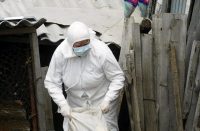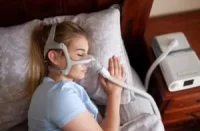
(Reuters) — A new blood test that acts as an early warning system for cancer is being developed by researchers at Swansea University. It works by detecting mutations in red blood cells in advance of cancer symptoms appearing, and could one day give GPs a simple, non-invasive way to screen patients before deciding whether further investigation is needed.
While the research has so far focused just on cancer of the oesophagus, the team hopes it could one day yields clues to the presence of cancerous tumors in advance of them becoming terminal. Professor Gareth Jenkins, who led the study, said that as mutation is the main driving force for cancer development, spotting it as early as possible is vital to increase chances of successful treatment.
Jenkins likens the test to a ‘smoke alarm’ in that it doesn’t detect the fire itself but the presence of smoke: “The by-product, the collateral damage that comes with the fire. Equally, in this blood test we don’t measure the presence of cancer, we measure the presence of mutated red blood cells which are the collateral damage that occur as a by-product of the cancer developing.”
The test can be done in any standard pathology department, and utilizes a standard analytical machine. The Swansea team has optimized it to look specifically for mutations in millions of red blood cells. While a healthy person typically has about 5 mutant cells per million, this number increases in cancer patients.
“The essence of the test is looking for very rare cells that have picked up a mutation, and so you have to have a very sensitive machine and you have to optimize the machine in a way that it encourages the detection of those rare events. The number of mutated red blood cells in a healthy person are around 5 or so mutant cells per million. So you have to look at millions of red blood cells to detect those rare events. These numbers increase in cancer patients by maybe an order of magnitude; they go up to 40 or 50 mutants on average,” Jenkins told Reuters.
Over four years of research, the team has screened about 300 individuals’ blood samples, using oesophageal cancer as their example to optimize the test.
A sample of blood cells stained with fluorescent antibodies is added to the device where precisely focused lasers are able to identify the presence of surface proteins on a red blood cell. In mutated cells some specific surface proteins are missing because they’ve lost the ability to attach to the membrane. The optimized device can differentiate between healthy cells with the surface proteins and the mutated cells without.
Jenkins said they’re now working to establish a threshold between a high and low chance of cancer being present.
“There seems to be an increase in the numbers of mutant cells between a healthy volunteer and the cancer patient, which is as much as an order of magnitude. So from 5 mutants per million up to around 40 or 50 mutants per million. So being able to set a threshold somewhere between those two values where we might be able to either inform a clinician that there is a high chance of someone having cancer or a low chance of someone having cancer,” he said.
Despite promising results from their initial study, Jenkins concedes there’s still a lot more work to be done before a test like this could be in doctors’ surgeries.
“One of the burning questions that we have at the moment is; we’ve only been looking at esophageal cancer patients, do other types of cancer patients have high levels of these mutant red blood cells as well? We don’t know the answer to that question at present.”
Enthusiasm is building for so-called “liquid biopsies,” which offer a non-invasive alternative to standard tissue biopsies and are expected to be a multibillion-dollar market.
The hope is that a test such as the one being developed in Swansea could eventually become part of a doctor’s standard kit, alongside other non-invasive tests that use a sample of breath or urine.
“A battery of tests based on different principles looking at different blood, looking at different bodily fluids – breath, urine… will be the best way to get a comprehensive view of whether an individual might or might not have cancer,” said Jenkins.
As well as checking for cell mutations much earlier, the hope is that liquid biopsies could be used as a simple way to sample tumor DNA in the blood to see if patients are responding to treatment, check for drug resistance, or see if cancer has returned. Eventually, they could be used to screen healthy patients. But many more studies are needed first.







